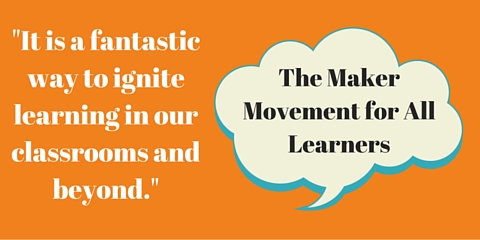The Maker Movement for All Learners
By Guest Blogger
Posted on 2016-05-21
All students can benefit from the Maker Mindset, which encourages students to believe they can learn to do anything. The Maker Movement is a resurgence of creating and making things by people of all ages and backgrounds. Learning through “making” can happen across a range of contexts and curricular areas and can be leveraged for inspiration and powerful student engagement.
Making can happen in a variety of places that might be labeled “maker spaces,” such as libraries, classrooms, museums, homes, or garages. But they don’t have to be labeled spaces—innovation and creating can happen on a table in a classroom. Some maker spaces may have the newest technological toys such as a 3D printer or laser cutter, but this is also not necessary; the focus in this design learning is not on the tools but on the process and product.
This approach is close in heart to the constructivist- and constructionist-based design work that focuses on engaging participants in learning content and process. This work provides students the opportunity to experience the hands-on intersection of critical thinking, engineering, computer science, circuitry, art, math, technology, and innovation.
Building Up to the Maker Movement
I have been a special services teacher and a regular classroom teacher for total of 31 years. I worked as an Einstein Fellow in DC at the National Science Foundation in 2012–2013 and became very involved with the Maker Movement in that year. I now work as a Science Technology Engineering and Math Outreach Coordinator and work with students and teachers doing STEM activities with a Maker emphasis, sharing all I learned in my fellowship as well as in my classroom practice. I have been extremely impressed with the enthusiastic participation of the students and teachers that I have worked with in the past two years in this role.
In these experiences, I have seen that students who have learning challenges are as engaged and as successful as any other learner, and often have unique and innovative perspectives and solutions to the design task at hand. Classroom teachers are excited to see their students’ involvement and investment in this learning as well. I work with the teachers and students for one to three sessions and provide the materials for the times I am there. I offer ideas and resource lists for teachers to follow up with and also give students (at the students’ request) sources where they can get materials for continued making. It is amazing how contagious learning through making can be for everyone!
There are many ways to do this in a low–tech, low budget, with an easy-access on ramp to making. Two books I highly recommend to get you started are:
- Invent to Learn, Making, Tinkering, and Engineering in the Classroom by Sylvia Libow Martinez and Gary Stager, Ph.D. (Chapter 14, Resources to Explore, gives you sources by topics and is worth the price of the book alone!)
- The Art of Tinkering, by Karen Wilkinson and Mike Petrich. (This is put out by the Exploratorium in San Francisco, and they have a great website: http://tinkering.exploratorium.edu/projects )
I wish you a happy final stretch of the school year and an exciting launch into or continued endeavors with Maker education. It is a fantastic way to ignite learning in our classrooms and beyond. The intellectual development that happens through direct, hands-on experience with creating and tinkering is empowering and something we can offer all students!
Author Sheryl Sotelo is a STEM outreach coordinator and educator in Alaska; contact Sotelo at sherylsotelo@gmail.com. This blog is part of a series being published by NSTA’s Special Needs Advisory board, the charge of which is to “Advise NSTA standing committees and NSTA headquarters regarding support for members with special needs and for teachers of students with special needs; make recommendations to the Executive Director and the Board of Directors regarding issues and projects related to special education.” Teresa M. Fulk is the board chair and can be contacted at fulkt@gcsnc.com with questions about the work NSTA does with this community.
The mission of NSTA is to promote excellence and innovation in science teaching and learning for all.
Future NSTA Conferences
5th Annual STEM Forum & Expo, hosted by NSTA
- Denver, Colorado: July 27–29
2017 Area Conferences
- Baltimore, Maryland: October 5–7
- Milwaukee, Wisconsin: November 9–11
- New Orleans, Louisiana: November 30–December 2
National Conferences
- Los Angeles, California: March 30–April 2, 2017
- Atlanta, Georgia: March 15–18, 2018
- St. Louis, Missouri: April 11–14, 2019
- Boston, Massachusetts: March 26–29, 2020
- Chicago, Illinois: April 8–11, 2021
Follow NSTA
Disclaimer: The views expressed in this blog post are those of the author(s) and do not necessarily reflect the official position of the National Science Teaching Association (NSTA).



